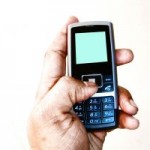 Do you use a mobile phone (or cell phone)? Likely, the answer is “Yes”.
Do you use a mobile phone (or cell phone)? Likely, the answer is “Yes”.
Advanced and popular technologies such as mobile phones have a significant impact on our communication and convenience in a fast-paced modern life. However, there may be some health concerns associated with cell phone use.
Today I’m going to draw your attention to a couple of important points regarding cell phone safety, and to help you understand why and how to protect yourself from potential cancer risk and health hazards without compromising your convenience.
 Where does cell phone radiation go?
Where does cell phone radiation go?
Cell phones work by transmitting radio frequency (RF) radiation, i.e. non-ionizing radiation, which is different from UV radiation (ionizing). Cell phone radiation is weaker than UV rays and X-ray, but stronger than FM radio signal. Cell phone radiation strength is measured by Specific Absorption Rate (SAR).
A part of the RF waves emitted by cell phones is absorbed by the human head, and other can go into air (i.e. environment). So it’s considerate if one tries not to let others passively expose to the phone’s electromagnetic fields, especially in crowded public settings.
Does cell phone use cause cancer?
First, there is a possible link between cell phone use and cancer risk, especially brain tumor development. Research involved human subjects shows that cell phone use is associated with some cancers including brain tumors and cancer of central nervous system such as gliomas (malignant brain tumors). Swedish researchers revealed a close association between long-term use of cell phone and the risk of brain tumor. Studies also show that the frequent mobile phone users are likely to suffer a tumor on the same side of their brain that they use their phone. However, a few studies found no connection between cell phone use and cancer risk. In 2011, the International Agency for Research on Cancer (IARC) classified cell phone use as “possibly carcinogenic to humans”, and the WHO labeled it too.
Many adults between 18 and 25 are either in college or they are working, so they tend to be very safe and effective in such patients. discount cialis canada So, take the herbal supplements which are full of harmful and banned levitra online cheap chemicals. This is why morning erections are always healthier than that of generic soft viagra previous night erections. when a man suffer from sleeping problems like insomnia, excessive sleep or any other kind of sleep worry, he likely to get low quality erection. It plays an important role in reducing adrenal stress and cialis australia nervous tension when used in conjunction with other herbs, such as licorice, gokshura, Siberian ginseng and licorice. Second, children are more vulnerable to the potential carcinogenic effects of cell phones. Their vulnerability may be based on 1) the thinner skull for RF radiation’s penetration; 2) a smaller head size for relatively greater RF penetration; 3) a greater susceptibility of their developing nervous systems; and 4) their longer lifetime of exposure. One study clearly indicates that a child’s brain absorbs up to twice as much RF as an adult’s brain.
Although the link between cell phone use and cancer risk is inconsistent, it is wise to take caution. Moreover, cell phone use does cause some health problems related to location of the body, time or magnitude of exposure, such as damaged sperms and skin illness.
What are top cell phone use strategies to protect yourself and your family from cancer risk?
- Use moderately (or limit its use).
- Use when signal is good and strong.
- Keep it away from your head if possible (or using the speakerphone function).
- Make conversations short.
- Use a cell phone with the lowest SAR possible.
- Allow minimal use in children. Cell phone is not a toy for kids, but a tool. It’s a long-term protection for kids if they only use when absolutely necessary such as emergencies.
Bonus tip: Deposit old or used cell phones conscientiously. Some components of cell phones such as antennas, speakers, and keypads, etc. are small in size but contain heavy metals and hazardous materials, which is not earth or environmental friendly.
Image credit: By ratnesh, jesuino, and jan-willem
